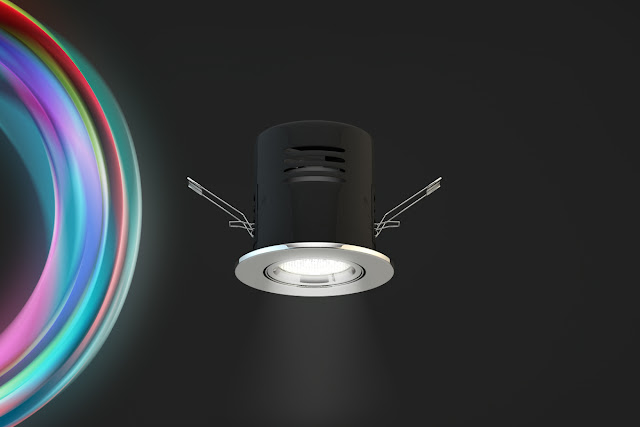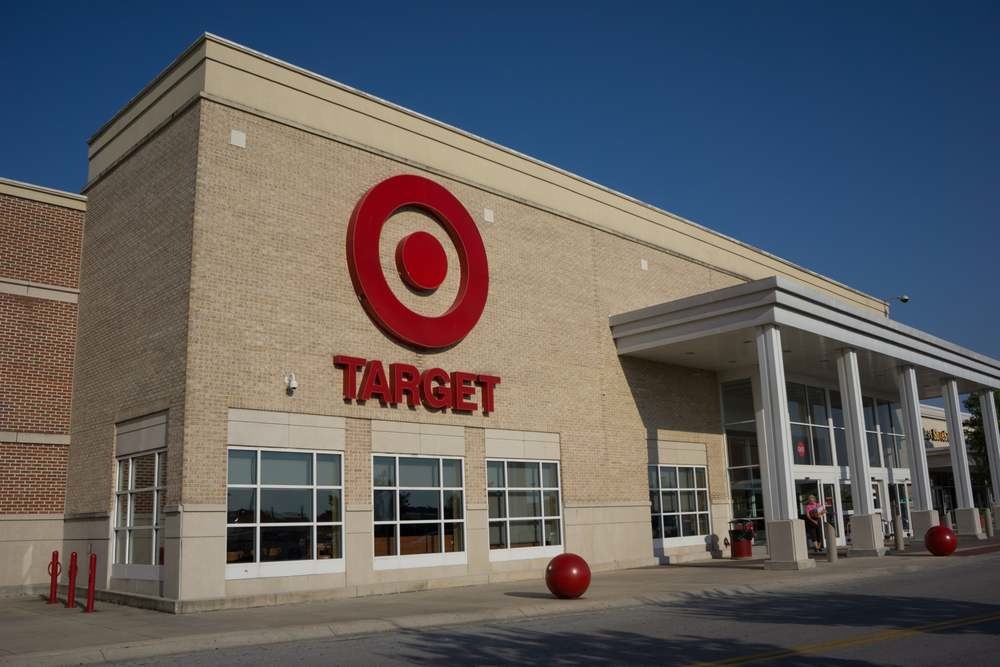CAT | LED downlights
Megaman are pleased to announce that they now offer serviceable LED solutions for a range of applications.
Across its LED product development in replacement lamps, modules*, light engines** or fixtures, MEGAMAN are pleased to announce that they are now able to offer user serviceable LED solutions. This decision has multiple benefits. Not only can MEGAMAN LED light sources be serviced and upgraded to the latest LED technology, but by using serviceable solutions, existing luminaires can be retained, minimising the environmental impact of progress. This approach overcomes some of the inflexibility previously experienced by end users, of completely integrated LED solutions.
MEGAMAN also recognizes that some basic light fixtures have such a low carbon footprint that engineering for replacing the LED may not always be viable and it can be greener to replace the whole fixture. MEGAMAN fixtures in this category are 100% recyclable with component parts that can easily be dismantled and separated. They are still designed with serviceability in mind so have commonly used fixings or sizes for easy replacement long into the future.
For MEGAMAN LED modules, light engines and fixtures it is recommended that the installation and servicing is performed by a qualified and competent expert.
The MEGAMAN LED product range offers the highest degree of design freedom for lighting designers, both in terms of addressing future advances in LED technology, as well as offering a wide range of colour and output choices.
* LED Module is a unit supplied as a light source. In addition to one or more LEDs it may contain further components, e.g. optical, mechanical, electrical and electronic components, but excluding the control gear.
** LED Light Engine is the combination of one electronic control gear, integrated or remote, and one or more LED modules.
For Megaman LED lighting solutions, please visit www.novelenergylighting.com, or call 0208-540-8287 to discuss your project needs.
led fixtures · megaman · Megaman LED · megaman led lamps · megaman led lighting · megaman led luminaires · Novel Energy Lighting
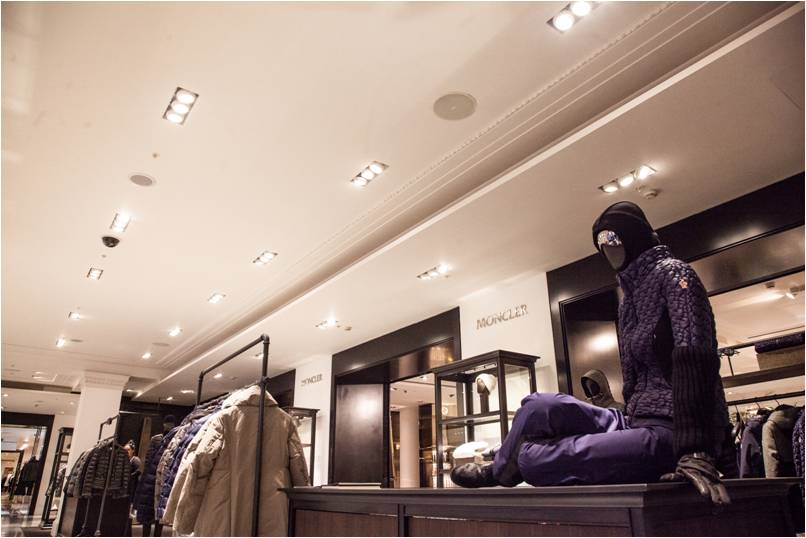
How can Megaman’s latest lighting solutions; including reflectors, modules and integrated fixtures enhance your retail application?
Attracting Customers
Lighting plays a crucial role in winning a customer’s attention, and designers are increasingly using it to enhance the shoppers experience, especially in high end retail shops.
Setting the Mood
Lighting affects customers mood and energy levels. It also provides guidance and orientation. The correct lighting creates a welcoming, comfortable and enjoyable environment, lengthening customers visits and influencing their buying habits.
Enhancing Product Appearance
A quality lighting system can make a big difference in retail settings by enhancing products visual appeal in terms of colour, shape and texture. Used correctly, lighting can provoke more interest in your product displays. For example; Megaman’s Perfect White technology enhances fluorescent whitening agents, making white products stand out from the crowd.
Creating a Desirable Instore Experience
Many luxury retail stores use a combination of ambient, accent and decorative lighting to create a positive shopping experience.
Visit www.novelenergylighting.com to explore the Megaman LED lighting range, or call us to discuss you retail lighting project. Tel: 0208-540-8287, email: sales@novelenergylighting.com
LED downlights · led GU10 · LED spots · Megaman LED · megaman lighting · Novel Energy Lighting · retail led · retail lighting · shop lighting
Megaman UK has launched an invaluable, simple to use online service to assist home owners, contractors, specifiers or anyone involved in lighting to calculate the potential savings that can be achieved when switching from standard light sources to Megaman’s energy saving LEDs.
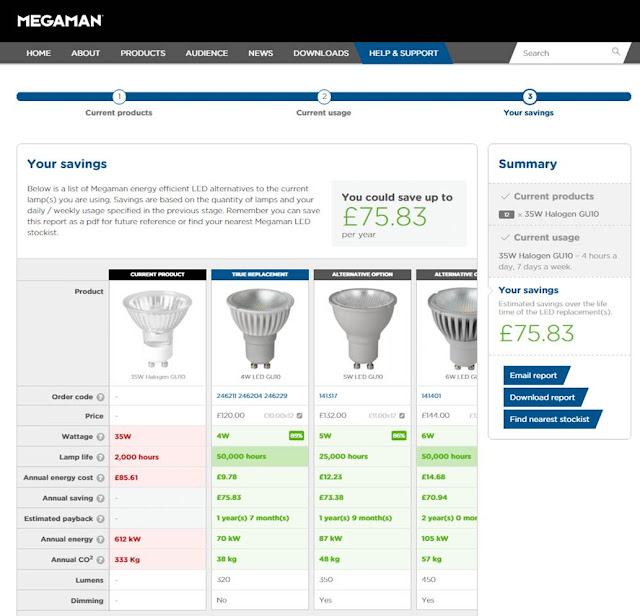
The new online tool, which is focused on the end user, uses quick and simple calculations to provide annual cost savings, payback and energy usage in kW and CO2. Different lamp types can also be compared at any given time to clearly show the savings involved in changing one room, two rooms or even a whole house to LED lamps using a mixture of Megaman’s LED lamps such as GU10, Classic or Candle ranges. This clever tool is also capable of generating a series of results that can be downloaded immediately or saved for assessment at a later stage.
Anyone wanting to take advantage of this service to evaluate their potential savings should visit the Megaman website where the new tool is ready to use.
energy calculator · energy savings · led cost of ownership · low energy lighting · megaman gu10 · Megaman LED · megaman lighting · megaman MR16 · megaman spots · Novel Energy Lighting
When should you use fire-rated downlights, and when you should, what one do you select from the dozens on the market? We bench test and rate the latest products from the major brands. Report by Lux technical editor Alan Tulla.
Report by Lux technical editor Alan Tulla
Did you know that different fire test standards can apply to downlights?
I didn’t, and what should have been just a single line mentioning the applicable standard turned into quite a lengthy investigation.
One simple way of fire-proofing any recessed luminaire is to fit a fire hood or tent over the top of it. You can buy hoods in various sizes for 30 minute, 60 minute and 90 minute fire ratings. They need to be fitted carefully though. You also need to check that, when fitted with a fire hood, the luminaire will not overheat in normal operation. You should be doing this anyway since many installations using recessed luminaires also have thermal insulation above in the void or there can be restricted ventilation.
However, this article is about recessed downlights where they form an intrinsic part of the fire resistance of the ceiling. There is a huge market for these products. Maybe the two commonest areas are: fitted to the ceiling of the top storey (e.g. beneath the loft or roof space) and kitchen areas on the ground floor where there is a false ceiling.
Before fitting fire-rated downlights, you should always what resistance (30 minutes, 60 minutes, 90 minutes) is required. The people most likely to know are the architect or building services engineer. If the ceiling is of a non-standard construction, check what fire test standard is applicable.
The Lighting Industry Association recommends that luminaires conform to BS 476-21. It also recommends conformance to BS EN ISO 140-3:1995 and 140-6:1998 which concerns the acoustic performance of the internal or separating floor.
The other relevant fire-test standard is EN 1365. This is a much more recent standard than BS 476. In fact, the test method and time/temperature curve is identical to BS 476 but there is a difference in how the thermocouple is used.
In a way, the term ‘fire-rated downlight’ is slightly misleading since the condition of the luminaire during and after the test is irrelevant. The intention of both test standards is to determine whether installing the luminaires compromises the integrity of the floor and ceiling construction.
Fire testing is, quite justifiably, expensive. Always ask to see a copy of the fire test certificate for the particular luminaire you are using.
Please remember that this article is a brief explanation of how the Fire Regulations (Part B) apply. The fire resistance of buildings is a specialist area of expertise and we recommend that you should always ask for advice from a competent person.
Aurora m10CX
Aurora has a huge range of fire rated downlights. One of the main features of its M Series is that it doesn’t have an external driver. Instead, there is an integrated circuit on board. This also removes the need for the electrolytic capacitor, which is usually considered to be the weakest component in an LED downlight.
The CX downlight has variable colour temperature from 2700K – 6400K and this can be altered remotely from a wall switch making it ideal for hospitality, retail, commercial and residential applications .
It’s good to see that it is also tested to BS EN ISO 140-3:1995 and 140-6:1998 Acoustics.
Fire test standard supplied: BS EN 1365-2
Collingwood H2 Pro 550
This is a comprehensively designed downlight. As well as being fire rated and mains dimmable, it is also IP65 so you can use it in bathrooms. The most recent version requires a depth of just 56mm above the ceiling.
Collingwood also claims (backed by independent lab testing) that flicker is less than 1 per cent. It has also been tested under the LIA Verified scheme.
There is also a choice of 11 bezels (six round, five square). A useful feature is that they can be fitted once the downlight is in place. This allows for finishing touches to the ceiling to be made without masking the light.
One extra, useful touch is that the 20-page leaflet has a large comparison chart showing all the options and combinations available.
Fire test standard supplied: BS EN 1365-2. Also LIA Verified scheme approved downlight.
Integral LED Fire rated downlight
This is a simple, compact and attractive downlight. Integral LED is a very technically competent company. It has its own labs in the UK and every product is fully tested. We have reviewed some of its other products and they consistently perform very well.
This unit is IP65 and solidly constructed with a cast aluminium heat sink. The chip-on-board LED is set up higher in the downlight than many of its competitors thus reducing any chance of glare. It also has a loop-in, loop-out driver making it easier to install.
As well as fire resistance, it is also tested for sound insulation and air tightness BS EN 13141.
Fire test standard supplied: BS 476-21 and 140-6:1998 Acoustics and others.
JCC FG LED
The FG LED series is available in three outputs from 380 lm to 850 lm. Colour temperature can be either 3000K or 4000K. The most powerful is the IP65 FG LED 10. This has a 60 degree beam as standard. This wider angle makes it suitable for kitchens where you want more general lighting.
The downlight is constructed as a perforated steel can with the finned heat sink inside. The driver is attached to the top of the can thus giving extra height to the downlight. This creates a much larger air pocket and JCC say that this means you can lay insulation directly over the fitting.
Fire test standard supplied: BS 476-21
Lumanor
This is a plain, budget-range cast aluminium IP65 downlight. It is only available in 10W and 2700K or 4500K. Five interchangeable bezels are available. The driver is remote and fitted with a short inter-connecting lead.
The fire test certificate supplied contained the barest minimum of information.
Fire test standard supplied: BS 476-21
Lumaxled
Again, a plain, budget-range cast aluminium IP65 downlight. It is a 9W unit and available in 3000K and 4000K. The colour rendering index is claimed to be greater than 85. The driver is remote and fitted with a short interconnecting lead.
Unusually, the downlight is tested to BS 476-23 which has different requirements from Part 21.
Fire test standard supplied: BS 476-23.
Nexus Luceco Atom
This is taller than most other downlights at 110mm. This is partly due to the bracket over the top which keeps any insulation clear of the heat sink and cable exit. It is rated at 5.2W and available in 2700K and 4000K versions. There is a 38 degree beam and the downlight is rated at IP65. Three bezels are available.
It has integrated circuitry so no separate driver is required.
Fire test standard supplied: BS 476-21
PAL All-In-One
This comes packaged with four bezels so there is no need to decide which you want before you buy. Another unusual feature is that driver has a slider switch so you can change the colour temperature from 3000K to 4000K or 6000K. Of course, you have to do this before inserting it in the ceiling but it does mean that you could change the colour temperature in the future. The beam is 40 degrees.
One bonus of this product is that it is LIA Lab verified.
Fire test standard supplied: BS 476-21
LED Group Robus Triumph Activate
The 8W Triumph Activate downlight has an integrated driver thus eliminating the electrolytic capacitor. It has a decent lens and reflector system giving a clean 38 degree beam. A 60-degree version is also available.
The general construction and wiring is very solid. It’s sometimes the little things that count, such as the firmly fixed plastic-coated spring clips that don’t fall out and the solid Swift cable connectors. These, together with the comprehensive installation instructions, data sheets and sales literature, give one a feeling of confidence.
Fire test standard supplied: BS 476-20 and BS 476-21
Scolmore Inceptor Max LED4500
There is a whole range of different products under the Scolmore group banner. Click wiring accessories may be the most well-known brand. Lighting products are branded Ovia.
In essence, this is an IP65, 8W with a 35 degree beam available in 2700K and 4000K with three bezel finishes. The company also makes a tiltable version.
A feature that sets this unit apart is that the driver is attached to the downlight body by a flexible strap. In the standard position, the driver is directly above the downlight and requires a recessed depth of 95mm. Unclipping the driver and flipping it over means that a depth of only 61mm is needed. You then need about 250mm (in any single direction) to accommodate the driver and Click Flow connector.
Fire test standard supplied: BS 476-21
UK Led Lighting Nico
This is a simple, budget-range, cast aluminium, 7W or 9W, IP65 downlight. It is available in 2700K, 3000K, 4000K and 5000K. Six interchangeable bezels are available. Beam width is 36 or 55 degrees. The driver is remote and fitted with a short interconnecting lead. It is just 63mm high but, like all other downlights, you need to follow the installation instructions carefully to ensure it doesn’t overheat.
Comprehensive fire test data was supplied for this unit.
Test standard supplied: BS 476-21
ansell · aurora · fire rated downlight · fire rated spot · LED downlights · led fire rated · lux magazine · Novel Energy Lighting · robus · spot lights
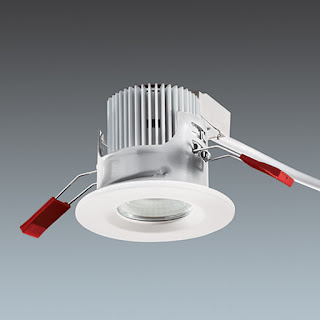
Thorn launches Cetus Mini: Expanding the existing Cetus LED range, Cetus Mini benefits from a special reflector optic with a beam angle comparable to MR16 lamps for visual uniformity. The option of fixed or adjustable recessed LED downlight comes with a high efficacy of up to 95Llm/W. With the integrated LED module it allows a recessed depth of <101mm for installation in shallow ceiling voids. Cetus Mini has a small 68mm ceiling cut out.

Cetus Mini is offered in two trim finishes, white or chrome. It is available with 550lm in colour temperatures of 3000K and 4000K and IP20 or IP65 for use in bathrooms. In addition fire rated (30, 60 or 90 minutes, 77mm ceiling cut-out) versions of Cetus Mini are available.
For more information about Cetus Mini, visit Thorn here.
Novel Energy Lighting offers a range of Thorn LED products, including panels, battens, and downlights. You can view the Thorn range here.
Tel: 0208-540-8287
Email: sales@novelenergylighting.com
led cetus · led downlight · led omega · Novel Energy Lighting · thorn aquaforce · thorn cetus · thorn cetus mini · thorn led · thorn leopard · thorn poppack
Philips and Cisco have formed a global strategic alliance that will combine Philips’ LED based connected lighting system with Cisco’s IT network to address a global office market estimated to be worth EUR 1 billion. The Alliance is designed to bring the benefits of the Internet of Things in offices to facilities managers, building owners and office workers.
The pair will combine Philips’ connected office lighting system using Power over Ethernet (PoE) technology with Cisco’s network technology. Light points in the Philips system, equipped with sensors and software applications, can be connected using Cisco technologies.
The lighting network creates a pathway for information and helps enable new services. The system can provide data to optimise user comfort and improve the office environment and office workers can personalise their lighting via their smartphones.
To showcase how Philips and Cisco can work together to unlock the benefits of the IoT in offices, Cisco is installing a state-of-the-art Philips connected lighting system at its Canadian headquarters in Toronto. Philips and Cisco will also collaborate on a joint go-to-market strategy.
Bill Bien, SVP, head of strategy and marketing, at Philips Lighting, said: “Our alliance has two of the world’s biggest and trusted lighting and connectivity brands working together to bring the Internet of Things to life in offices and commercial buildings across the world. Customers will receive the best energy efficient lighting experience in the connected world and be able to use information acquired from their connected lighting system to save energy, reduce costs, improve productivity and optimise their workspace environment. Lighting that is connected to highly secure, reliable IT infrastructure will form the backbone of the smart office of the future.”
Together Philips and Cisco aim to accelerate adoption of this technology in the market and deliver increased connectivity, comfort and efficiency.
Edwin Paalvast, SVP EMEAR, Cisco and executive sponsor of the Cisco – Philips Alliance, said: “The world is becoming digital, and by working with Philips, we can help building owners more quickly digitise their lighting networks to drive better user experiences and efficiency. By partnering with Philips, we are delivering a reliable PoE-powered LED lighting solution using a highly secure IT network.”
Typically, lighting is responsible for 40 percent of a building’s electricity use. The pair estimate that nearly 80% in energy savings and reduced building maintenance costs can be realized by managing, integrating and controlling a Philips LED connected lighting system through a network with Cisco.
To make offices more comfortable, office workers can personalize and adjust LED lighting to their preferences and tasks. For mobile access, office workers can use a smartphone app to access other building services through a communications network.
“The possibilities of this connected lighting system are endless,” said Richard Lees, senior project manager at CBRE, a commercial real estate and investment services firm. “There are so many capabilities of this system that we haven’t even explored yet.”
Visit www.novelenergylighting.com to explore what Philips LED lighting can do for your next project.
cisco · LED downlights · led lighting · led panels · led tubes · Novel Energy Lighting · office lighting · philips led · philips lighting
American retail giant Target has revealed that 100 of its stores are now deploying LED ceiling lights to track in-shop customers and guide them to relevant products via their smartphones, a nascent practice which could become the biggest thing in brick-and-mortar retail technology since the barcode.
The $73 billion chain told Lux that the scheme uses wireless signals that travel between LED lights and shoppers’ Android gadgets. The 100 locations mark the largest known deployment of ‘spy lights’ by any retailer, and could spur broader uptake.
Lux disclosed last April that Target was pioneering the technology at a small number of stores, where it is monitoring customers, pinging them with promotions, guiding them straight to relevant and discounted products, and tying them into loyalty schemes.
At the time the Minneapolis-based group declined to confirm it. The company has now decided to say more. But not much more.
‘This fall, in about 100 stores, Target began testing technology with new LED lights that can provide in-store location information to guests using the Android version of the Target app with select Android phones,’ a spokesperson told Lux. Target calls its customers ‘guests.’ The company made no mention of iPhone support.
Target would not reveal which wireless networking technology it is using. It is believed to be testing both ‘visible light communication’ (VLC), as we reported in April, as well as Bluetooth.
VLC encodes product information in the flickering wavelengths of LED light – the flicker is imperceptible to the human eye – and transmits that information to the camera of a user’s phone. Proponents of VLC say it is more accurate than other technologies such as Bluetooth, and can thus pinpoint a product and a customer’s location in a store and can more precisely steer a customer to a product in a large, difficult to navigate shop.
But advances in the better-known Bluetooth could possibly make it a contender for so-called ‘indoor positioning.’
‘With this pilot, the app provides “blue dot” navigation assistance in the app’s store map to help guests more easily find what they’re looking for as they shop our stores,’ the Target spokesperson said, noting that customers ‘can choose to disable this pilot functionality with the app.’ A ‘blue dot’ denotes a customer’s current location on a floor map of the store displayed on the Target app, he explained.
Other retailers are also experimenting with indoor positioning systems.
France’s Carrefour, the world’s third largest retails chain, is running a pilot based on Philips technology at a 7,800-square foot outlet in Lille, France. Philips is considering offering
VLC as a service.
GE claims to have two trial VLC customers in Europe and two in the US, although it will not publicly name them.
Target would not reveal the technology provider. In addition to Philips, VLC suppliers include GE, Acuity (which buoyed its VLC capabilities earlier this year by purchasing specialist ByteLight),Qualcomm and Scottish startup PureLiFi, among others. Acuity’s eldoLED division will demonstrate VLC at this week’s
LuxLive exhibition in London on Wednesday and Thursday.
Smart lighting startup Gooee is marketing an embedded technology platform that provides indoor positioning through Bluetooth mesh. Indoor positioning is one feature among several in what Gooee calls its ‘IoT Stack’ – an ‘Internet of Things’ engine that when embedded in lights will help them intelligently support a host of operations including people and product tracking, building security, and lighting management and maintenance. Gooee is
showing the technology at LuxLive.
Indoor positioning is expected to usher in a brave new era of personalising a shopper’s in-store shopping, and tailoring it with promotions, ads and information in a manner akin to today’s online shopping.
internet of things · iot · led ceiling lights · led lighting · lifi · lux · Novel Energy Lighting · target stores · visible light communication · vlc
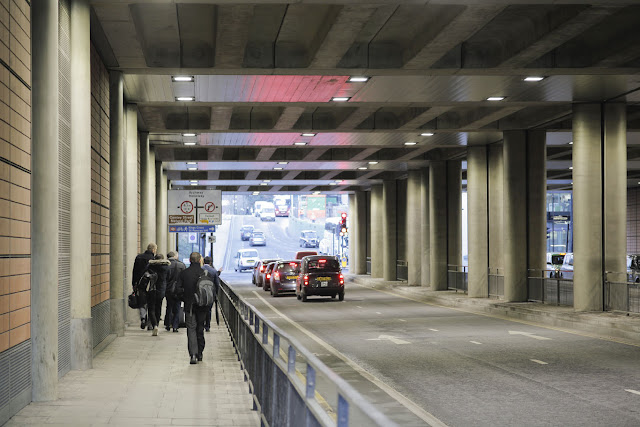
This underpass near King’s Cross and St Pancras stations in North London is saving money on energy and maintenance since it had its old metal halide lights replaced with specially designed LED road tunnel luminaires from Philips.
The St Pancras Road underpass is a busy road, cycle and pedestrian route to the two major train stations, as well as providing access to Camden Council’s new offices. It was previously lit by around 100 twin-lamp metal halide fittings and the council saw an opportunity to visually improve what had become a gloomy and uninviting area. This was a ‘spend to save’ initiative to take advantage of energy-efficiency gains and lower maintenance costs while also reducing carbon emissions.
The lighting design was carried out by Philips and the new luminaires were installed by main contractor SPIE. SPIE’s John Broster said: ‘The previous luminaires were fitted into the soffit of the underpass and as this is a concrete strutted roof it would have been impractical to alter it. We needed a solution that could provide a direct replacement for the existing fittings.’
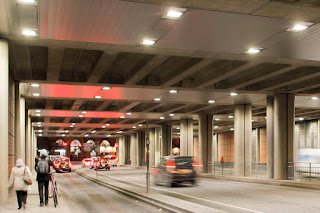
The stainless steel luminaires have been installed on a one-for-one replacement basis, to provide energy savings of more than 50 per cent. The new lighting has increased light levels and uniformity to remove the gloom, while the 4000K neutral white colour temperature has created a better and more inviting visual environment for users of the underpass. The tunnel feels safer and more pleasant.
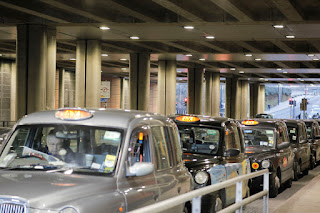
The project also provided an ideal opportunity to make better use of lighting control. ‘As this is a short underpass the lighting only requires one-step dimming and we were able to adjust the existing system, using high light levels during the day and dimming at night to minimise the contrast for drivers entering the underpass,’ said Broster.
The council has achieved a significant reduction in energy consumption, while also reducing maintenance costs as the luminaires are expected to be virtually maintenance-free throughout their lifetime, and should pay for themselves in about five years.
Contact Novel Energy Lighting to discuss your LED lighting retrofit requirements. We work hand in hand with the major lighting manufacturers like Philips to specify, supply, and install projects. Tel: 0208-540-8287. Email: sales@novelenergylighting.com
led floods · LED lamps · led lighting · LED luminaires · led tunnel lighting · lux · Novel Energy Lighting · philips led · street lighting · tunnel lighting · urban lighting
<< Latest posts
Older posts >>

